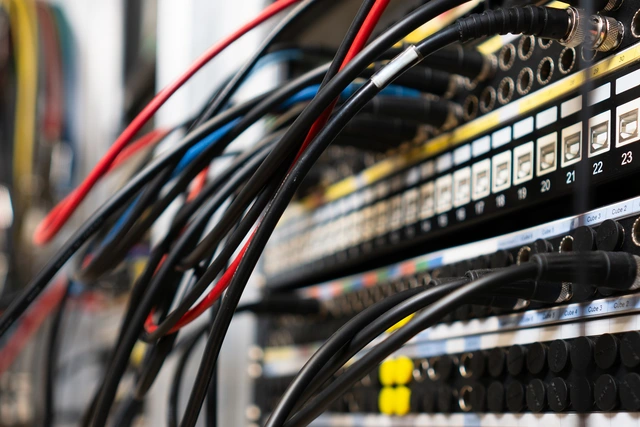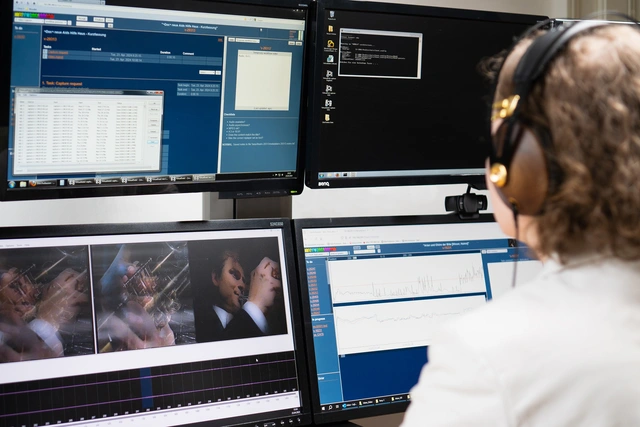Audio and video digitization at the Österreichische Mediathek
On this page
Permanent preservation through digitization
The tape recording of a reading from the 1970s, a radio report from the 1980s dubbed onto a cassette or a demonstration from the 1990s recorded on video: The accessibility of the content of many of these historically relevant recordings is permanently at risk.
Audiovisual media only has a limited shelf life in archives and libraries - even under optimal storage conditions. In addition, not only the media but also the playback devices are subject to technological change and many of these devices are already no longer commercially available. The only chance of permanently preserving the content of analogue audiovisual data carriers is to digitize the material.
The Österreichische Mediathek has had a tried and tested complex digitization system in the field of audio and archiving technology since 2000. At the beginning of 2011, a system for professional video digitization was also put into operation.
As "original" as possible
The aim of digitization is to create a digital copy that is as similar as possible to the original. This means that the digitization process is interfered with as little as possible or only as little as necessary. If improvement measures are necessary for certain recordings, these can easily be carried out on the digital copy afterwards. However, the decisive factor for the result is the creation of a high-quality original that is as true to the original as possible.
Digitization process
1. Catalog
The digitization process begins with cataloguing: descriptive metadata (title, persons, date of recording, information on content, etc.) are entered into the catalog database (DABIS / BIS-C 2000, modified) and each archival item is assigned a unique signature. This signature serves not only to locate the physical carrier in the analogue archive of the Österreichische Mediathek, but also as a unique identifier of the digitized item on the digital mass storage device.
2. Cleaning and restoration of the carriers
A central problem with digitization is the contamination of the archive materials. For example, dust can settle on the reading head during the digitization process and thus lead to massive failures. To avoid this, the archive materials are cleaned where possible before importing.
In the audio sector, the focus is primarily on the often necessary restoration of the analog source material: torn magnetic tapes on audio cassettes must be glued and installed in new cassette sleeves, any existing and detached adhesive spots on audio tapes must be renewed, missing leader tapes must be added and - for example, in the case of rust on the tape carrier (bobby, winding core) - the entire magnetic tape must be rewound onto a new, clean tape carrier. Special cleaning processes are used to remove spores from mould-infested magnetic tapes, and tapes that have become sticky due to hydrolysis processes and are therefore unplayable are 'baked' in dehydrators before digitization (tape baking) to make them playable again.
All of these cleaning, preservation and restoration techniques not only lead to better digitized material, but also protect the playback devices.
In the video sector, cleaning devices were primarily produced for the professional market and are therefore only available for certain formats. In the Österreichische Mediathek we can cover the following formats with cleaning devices: U-matic, Beta (Betamax, Betacam, Digitbeta), VHS and DV.
3. metadata on the format of the source material and the digitization process (evaluation)
The analogue carrier is first described in detail (format, manufacturer, playback speed for magnetic audio tapes, condition of the source material, etc.) and the entire signal chain in the digitization process is recorded: Playback device, A/D converter (analog-to-digital converter), settings of the A/D converter, workstation, software. This technical metadata is saved as XML files using the digitization systems for audio and video. They are saved in the same way as the digitized material.
4. Digitization process
Digital archive master - containers and codecs
In the archive context, the "archive master" refers to the file whose permanent preservation is to be ensured as part of long-term digital archiving. Accordingly, the choice of format for an "archive master" is of particular importance.
Audio digitization
There are clearly defined guidelines for the long-term digital archiving of sound recordings: The Safeguarding of the Audio Heritage: Ethics, Principles and Preservation Strategy (IASA-TC 03).[1] These were drawn up by the International Association of Sound and Audiovisual Archives (IASA) and form the basis for the professional archiving of audio documents. In accordance with these guidelines, the sound digitized files of the Österreichische Mediathek are created and preserved in the following form:
Archive master:
Format: Broadcast Wave
Resolution: 96 kHz/24 Bit
Viewing copy:
Format: MP3
Bit rate: 128 kbit/s
Six workstations are currently available in the audio area for A/D conversion, whereby up to four processes can run in parallel at each of these digitization stations. In addition, 4 CDs can be recorded (ripped) in parallel at one station. This means that up to 28 audio digitization processes can currently be carried out simultaneously at the Österreichische Mediathek. All common formats can be covered. In addition to the digitization process, a preview copy is created in automated processes (MP3), checksums are calculated (MD5) or specially assigned tasks such as normalization or channel manipulation are carried out.
The following audio formats are digitized in the Österreichische Mediathek:
- Audio cassettes
- Tapes (full-, half- und quarter track recordings with tape speeds from 4.75 to 76cm/sec)
- Digital Audio Tapes (DAT)
- Minidiscs
- records (33 ⅓ und 45 rpm), shellacs (78 rpm) and
- self-cutting films
- CDs (as 1-track Rip, 44.1/16)
Video digitization
Five stations are currently available for the digitization of video formats, so that up to five digitization processes can run in parallel. Once a recording has been digitized, it is 'processed' using automated processes of the digitization workflow so that all information is available for quality control. The automated processes include the creation of a viewing copy (MPEG-4) and preview images (per minute/per cut), cut detection, the generation of analysis graphs for quality control and the calculation of checksums (per minute).
In contrast to the audio sector, there are no guidelines for the digital long-term archiving of video. Only a few formats (codecs, containers) meet the requirements for digital long-term preservation. Among the possible options, FFV1 has proven to be the ideal format for long-term archiving (lossless compression, data reduction by a factor of 2-3, open format (open source), widespread distribution and large selection of applications).
Archive master
Video Codec: FFV1
Audio Codec: PCM, uncompressed
Container: MKV
Viewing copy
Format: MPEG-4
The following video formats are digitized at the Österreichische Mediathek:
- U-matic (Highband, Lowband, SP)
- MII
- Betacam, Betacam SP
- Digital Betacam
- VHS, VHS-C
- S-VHS, S-VHS-C
- Video 8
- Hi8
- Betamax, Superbeta
- DV, DVCAM, HDV
- DVCPRO 25
5. Quality control
Quality control comes at the end of every digitization process. Here, the digitized material is carefully checked using analysis graphs. The aim is to uncover and avoid any problems in the digitization process. The difficulty with quality control lies in distinguishing which artefacts are part of the content and which could have been created during the digitization process. The aim here is not to correct errors that are part of the content, but simply to ensure that the digitized version corresponds as closely as possible to the original.
Do you have any questions?
Your point of contact for questions about digitisation in the Austrian Media Library:



